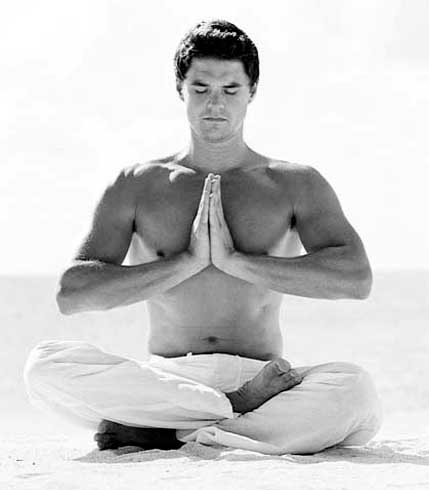
All about Yoga
Syed Sarwar Alam Chowdhuri | Saturday, 25 July 2015

Yoga is a way of life. It energises all organs and equally harmonises both sides of the body. Some say it is just an exercise. But it is not simply an exercise. Learners of Yoga face numerous difficulties in modern society, such as official duty, financial commitments and demands to the society. Moreover, they are trapped in unavoidable socio-political conditions, noise and unwanted bustle.
Yoga is a special mode of exercise. Body and mind cannot withstand stress and strains for a long period. It needs relaxation and strain-bearing capacity. Mind cannot go alone without body, body needs energy and mind helps to invigorate activities. Unification of body and mind is important. Yoga synchronizes body and mind.
Yoga is derived from a Sanskrit word "Yuj" which means union or bringing together. It unifies one with infinite power and brings harmony within. There are six branches of Yoga. Each branch has a specific approach. Of them 'Hatha Yoga' deals with human body and mind for greater benefit.
Yoga helps to develop body, mind and intellect through its disciplinary approach. It brings harmony into forces of body, the muscles, limbs, joints, and circulatory, respiratory, glandular and excretory systems.
Yoga has its own philosophy. It creates awareness about infinite reality, develops consciousness and purifies conscience.
All poses of Yoga have meanings and they heal illness. Poses are static but they initiate healing process if required and boost immune power of the body. Perfection in body and mind is difficult that can be achieved through Yoga poses and pranayama (breath control). Yoga beautifies body and synchronizes it with mind. Yoga poses ('asans') in combination with 'pranayama' and 'mudra' spark splendour in organs, fill heart with infinite joy and create a serene feeling that invokes beauty.
Perfection of all Yoga poses is necessary, certain poses with breathing control massage internal organs of the body so they can function more efficiently and trim as well to help ease movement and tone up the central nervous system.
Human body is unique. Muscles are attached with bones with skin developed over and blood vessels, glands and all vital organs are beneath and supported by skeleton. All parts of the body need care. Yoga poses are static but they stretch different parts of the body to supply blood for nourishment of organs.
Yoga and cells: It is worth mentioning that cells are fundamental building blocks of the body. Cells die and are replaced by new ones which need nourishment. Yoga poses and pranayama (breathing exercise or breath control) systematically push sufficient blood cells to organs to meet their requirements. It should be remembered that all organs are made up of cells. According to yogis body possesses all that are found in our world. So our body is a small universe. Yoga, pranayama and mudra energise body parts including blood cells to initiate healing process if necessary and bolster the immune response. Nerves control and propel all organs to function properly. When a nerve is damaged, the function of certain parts of the body ceases unless it is healed. Brain is the centre point of all nerves. In a simple word brain orders all limbs to work and function of the body starts. So brain needs enough blood supply. Only Yoga poses and pranayama can do it effectively. According to yogis Yoga poses and pranamaya keep brain cells healthy for a long time and delay brain cells' dying process. It is worth mentioning that after 40 our brain cells start dying and are never replaced by new ones.
Our body contains 31 pairs of nerves that run from coccygeal region of the body to brain through vertebrae. Coccygeal region is the base of the body, when we seat it connects us with the earth. The vertebral column of the body possesses 33 bones, to keep us erect, so, we can stand upright. If any problem arises in any vertebra body function hampers. Yoga poses take care of them. We know elasticity is essential to withstand any odd situation. Yoga poses help to develop and maintain body-electricity. Through practice we can learn extreme poses as well at any age which are required for certain benefits. Age is not any bar for learning Yoga; it can be learnt from early age up to 90+ years. All Yoga movements arouse out of need of the mind and body.
Origin: Yoga practices began thousands of years ago in our region but gained popularity in the West. It is more than 6,000 (six thousand) years old but wise man Pantan Jali who codified it, lived in third century BC.
Yoga has a philosophy. It teaches us our relationship with Infinite Cosmic Consciousness. Yoga creates awareness within to understand what consciousness is. We cannot detect anything unless sense organs translate out what exactly it is. We see objects as the visual nerve tells us to see them. Existence of anything is nothing but an illusion unless told by our sensory organs. If anything is detected without sensory means, we can get the point of Ultimate Reality. Yoga helps the mind to flourish and reach that stage.
In this vast universe existence of flora and fauna kingdom is minute. A person is a part of them. If the person enters there without losing his/her own identity, the person becomes a whole of the universe. Though individuality of the person remains intact, only consciousness is given up to the 'Infinite Cosmic Consciousness' that is 'Ultimate Reality'. At the end Yoga leads towards meditation. Mind is more powerful than the body, it is infinite, when it expands beyond limit unknown becomes known, mystery reveals.
Yoga has eight (8) limbs -- 'Yama, 'Niyma, 'Asan, 'Pranayama', 'Pratyahara', 'Dharna', 'Dhyana', 'Samadhi'. All those are needed to reach the point of 'Ultimate Reality', say Yogis.
The writer is a Yoga teacher and Principal of Yoga Home.